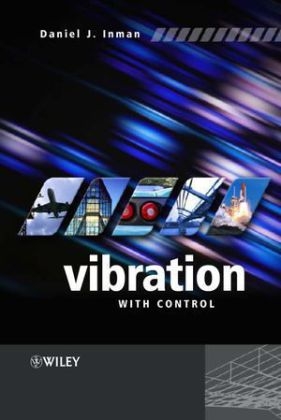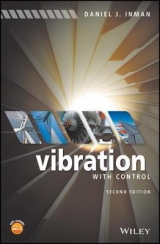
Vibration with Control
John Wiley & Sons Ltd (Verlag)
978-0-470-01051-8 (ISBN)
- Titel erscheint in neuer Auflage
- Artikel merken
Key Features:* Assimilates the discipline of contemporary structural vibration with active control* Introduces the use of Matlab into the solution of vibration and vibration control problems* Provides a unique blend of practical and theoretical developments* Contains examples and problems along with a solutions manual and power point presentations Vibration with Control is an essential text for practitioners, researchers, and graduate students as it can be used as a reference text for its complex chapters and topics, or in a tutorial setting for those improving their knowledge of vibration and learning about control for the first time. Whether or not you are familiar with vibration and control, this book is an excellent introduction to this emerging and increasingly important engineering discipline.
Daniel J. Inman; Director, Center for Intelligent Material Systems and Structures, 310 Durham Hall, Mail Code 0261, Virginia Tech, Blacksburg, VA 24061 USA Since 1980, he has published five books (on vibration, control, statics, and dynamics), eight software manuals, seven book chapters, over 160 journal papers and 300 proceedings papers, graduated 35 Ph.D. students and supervised more than 55 MS degrees. He is currently Technical Editor of the Journal of Intelligent Material Systems and Structures (1999-2004), Technical Editor of the Shock and Vibration Digest (1998-2001), and Technical Editor of the journal Shock and Vibration (1999-2004).
Preface. 1. SINGLE DEGREE OF FREEDOM SYSTEMS. Introduction. Spring-Mass System. Spring-Mass-Damper System. Forced Response. Transfer Functions and Frequency Methods. Measurement and Testing. Stability. Design and Control of Vibrations. Nonlinear Vibrations. Computing and Simulation in Matlab. Chapter Notes. References. Problems. 2. LUMPED PARAMETER MODELS. Introduction. Classifications of Systems. Feedback Control Systems. Examples. Experimental Models. Influence Methods. Nonlinear Models and Equilibrium. Chapter Notes. References. Problems. 3. MATRICES AND THE FREE RESPONSE. Introduction. Eigenvalues and Eigenvectors. Natural Frequencies and Mode Shapes. Canonical Forms. Lambda Matrices. Oscillation Results. Eigenvalue Estimates. Computational Eigenvalue Problems in Matlab. Numerical Simulation of the Time Response in Matlab. Chapter Notes. References. Problems. 4. STABILITY. Introduction. Lyapunov Stability. Conservative Systems. Systems with Damping. Semidefinite Damping . Gyroscopic Systems. Damped Gyroscopic Systems. Circulatory Systems. Asymmetric Systems. Feedback Systems. Stability in the State Space. Stability Boundaries. Chapter Notes. References. Problems. 5. FORCED RESPONSE OF LUMPED PARAMETER SYSTEMS. Introduction. Response via State Space Methods. Decoupling Conditions and Modal Analysis. Response of Systems with Damping. Bounded-Input, Bounded-Output Stability. Response Bounds. Frequency Response Methods. Numerical Simulations in Matlab. Chapter Notes. References. Problems. 6. DESIGN CONSIDERATIONS. Introduction. Isolators and Absorbers. Optimization Methods. Damping Design. Design Sensitivity and Redesign. Passive and Active Control. Design Specifications. Model Reduction. Chapter Notes. References. Problems. 7. CONTROL OF VIBRATIONS. Introduction. Controllability and Observability. Eigenstructure Assignment. Optimal Control. Observers (Estimators). Realization. Reduced-Order Modeling. Modal Control in State Space. Modal Control in Physical Space. Robustness. Positive Position Feedback Control. Matlab Commands for Control Calculations. Chapter Notes. References. Problems. 8. VIBRATION MEASUREMENT. Introduction. Measurement Hardware. Digital Signal Processing. Random Signal Analysis. Modal Data Extraction (Frequency Domain). Modal Data Extraction (Time Domain). Model Identification. Model Updating. Chapter Notes. References. Problems. 9. DISTRIBUTED PARAMETER MODELS. Introduction. Vibrations of Strings. Rods and Bars. Vibration of Beams. Membranes and Plates. Layered Materials. Viscous Damping. Chapter Notes. References. Problems. 10. FORMAL METHODS OF SOLUTION. Introduction. Boundary Value Problems and Eigenfunctions. Modal Analysis of the Free Response. Modal Analysis in Damped Systems. Transform Methods. Green's Functions. Chapter Notes. References. Problems. 11. OPERATORS AND THE FREE RESPONSE. Introduction. Hilbert Spaces. Expansion Theorems. Linear Operators. Compact Operators. Theoretical Modal Analysis. Eigenvalue Estimates. Enclosure Theorems. Oscillation Theory. Chapter Notes. References. Problems. 12. FORCED RESPONSE AND CONTROL. Introduction. Response by Modal Analysis. Modal Design Criteria. Combined Dynamical Systems. Passive Control and Design. Distribution Modal Control. Nonmodal Distributed Control. State Space Control Analysis. Chapter Notes. References. Problems. 13. APPROXIMATIONS OF DISTRIBUTED PARAMETER MODELS. Introduction. Modal Truncation. Rayleigh- Ritz-Galerkin Approximations. Finite Element Method. Substructure Analysis. Truncation in the Presence of Control. Impedance Method of Truncation and Control. Chapter Notes. References. Problems. APPENDIX A: COMMENTS ON UNITS. APPENDIX B: SUPPLEMENTARY MATHEMATICS. Index.
| Erscheint lt. Verlag | 30.6.2006 |
|---|---|
| Zusatzinfo | ill |
| Verlagsort | Chichester |
| Sprache | englisch |
| Maße | 175 x 248 mm |
| Gewicht | 872 g |
| Einbandart | gebunden |
| Themenwelt | Technik ► Elektrotechnik / Energietechnik |
| Technik ► Maschinenbau | |
| ISBN-10 | 0-470-01051-7 / 0470010517 |
| ISBN-13 | 978-0-470-01051-8 / 9780470010518 |
| Zustand | Neuware |
| Haben Sie eine Frage zum Produkt? |
aus dem Bereich



